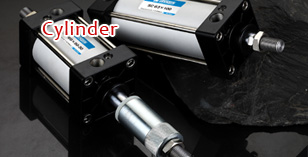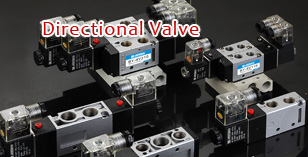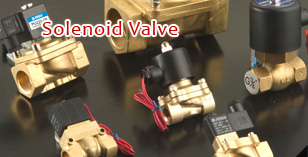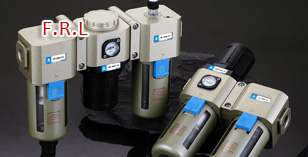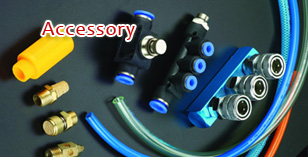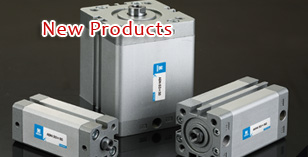|
Point-of-use filter-regulator-lubricators (FRLs) ensure that every device, tool, or process receives a clean, lubricated supply of compressed at the proper pressure to provide peak performance. Fortunately, FRL manufacturers offer engineering guidance, in catalogs and online, regarding how to select and efficiently use their products. We found that much of this advice holds regardless of the specific product and the application where it is used. Here are some common themes for improving system efficiency when using filters, regulators, and lubricators.
1.Use the right size filter — Size the filter for minimal pressure drop at the highest flow through the assembly. Most filter manufacturers define pressure loss and dirt-holding capacity using curves related to pressure and flow. Therefore, select particle-removal filters based on acceptable pressure drop and pipe-connection size.
Undersized filters are a prime cause of high-energy costs. That’s because restrictions and pressure losses throughout a circuit require higher generating pressure up front. And running the compressor at a higher setpoint consumes more electricity. As a general rule of thumb, every 2-psig increase in operating pressure adds an additional 1% in compression energy costs.
Typically, a larger filter produces less initial pressure loss and provides longer operating life than a smaller filter with the same removal rating. Using a smaller filter to save money up front will almost always cost more in the long run, as it results in higher initial pressure drop and also blocks more quickly because of smaller dirt-holding capacity.
2. Use the right level of filtration — Select the level of filtration that’s appropriate for the application. Unnecessary levels of treatment can significantly increase energy costs because a very fine filter, such as a coalescing filter, has a greater resistance to flow than a coarse filter. Many plants only need very-high-quality air for specific operations. For example, while servopneumatics may need 5-μm filters, and paint spraying 0.1-μm filtration, air tools usually work fine with 40-μm filtration. In most cases, users can see significant saving by treating all the air to minimum acceptable levels while only filtering to higher cleanliness levels at the point of use. When required, place higher-grade filters as close to the application as possible. This ensures that the filter size, determined by flow, is as small as possible and minimizes system pressure drop.
3. Change the element — Filter maintenance is also critical. In service, the filter element traps contaminants and, over time, eventually reaches its dirt-holding capacity. As this happens, the pressure differential across the filter rises substantially and wastes energy. Changing the element at this point means significantly lower energy consumption.
All filters should be fitted with low-cost differential pressure gages (pressure-drop indicators) that show when filter replacement is needed; electrical differential-pressure sensors are also available to provide remote signaling. Normally, general-purpose filter elements should be changed when pressure drop is around 7 psi (0.5 bar). High-efficiency filter elements should be replaced when pressure drop hits 10 psi (0.7 bar). Also, consider installing duplex filters in critical circuits that cannot be shut down to change elements.
4. Do your homework — All filters are not the same. The energy efficiency of filters with the same micron rating can vary by type of construction, the filter media, and the manufacturer. In general, higher-quality air filters have a lower pressure drop than low-quality ones. The latter also tend to clog more quickly than high-quality units. Not only does this mean shorter replacement intervals, the pressure drop across the filter will increase quicker, further hurting efficiency. And when comparing filters, look not only at pressure drop and energy consumption at maximum rated flow, but also at flows more typical of actual use.
5. Use regulators — Unregulated or improper pressure settings can result in higher compressed-air demand, which increases energy consumption. Pneumatic equipment that operates at pressures higher than recommended wastes compressed air and can accelerate component wear, resulting in higher maintenance costs and shorter equipment life.
To use compressed air most efficiently, reduce the pressure to the level the application requires. Regulators are special valves that reduce supply pressure where the highest levels are not needed. A common example is a double-acting cylinder where little force is required on its return stroke.
Several types of regulators are available, including general purpose, precision and pilot operated, so users must weigh performance characteristics and cost as well as efficiency. Determine the regulator’s size based on downstream flow and pressure requirements. While an undersized regulator will not be able to provide the required air pressure during maximum flow conditions, an oversized regulator will cost more than necessary to do the job. Consult manufacturers’ engineering data to determine the pressure characteristics of specific units.
6. Right-size lubricators — Most moving parts require some form of lubrication, and properly lubricated pneumatic components work better and use less air. Air-line lubricators inject a preset amount of oil mist or fog into the air stream, which is then delivered to downstream devices. They work on the basis of a pressure differential causing the oil to atomize. Thus, all lubricators cause pressure loss.
As with other air-preparation components, size a lubricator for a particular application based on downstream requirements. Lubricators typically have a larger flow range than an equivalent-size filter or regulator, but their pressure drop increases quite rapidly as flow increases. Acceptable pressure loss for a lubricator is normally considered to be 3 to 7 psig. Manufacturers provide charts in catalogs and online to help determine lubricator pressure drop at the required flow rate and pressure.
7. Eliminate the lubricator — One way to minimize any pressure drop caused by the lubricator is to eliminate it altogether – by using a nonlubricated system. For example, TRD Manufacturing makes pneumatic cylinders designed to operate without the need for external lubrication while reportedly meeting the demands and life expectancy in many commercial and industrial applications. These cylinders are lubricated during factory assembly with a special Teflon-based grease that deposits a fine protective and lubricating film on all moving components.
One benefit: it offers excellent resistance to lubrication migration. In long-stroke and vertical applications, the lubricant can evaporate or migrate and leave portions of the cylinder rod unprotected. This, in turn, permits direct metal contact that accelerates seal wear and failure. Nonlubricated systems also eliminate the need for oil-removal mufflers — and the pressure drop they create — that pneumatic systems normally need to filter the exhaust air.
These cylinders are suitable for high-speed applications up to 120 in./sec. While many factors contribute to overall cylinder life, TRD says the cylinders are usually rated for thousands of miles of travel, which translates into millions of operating cycles. However, all things being equal, cylinders with a continuous and uninterrupted supply of lubricating oil generally have a longer life.
8. Use prepackaged FRLs — Manufacturers commonly preassemble filters, regulators, and lubricators to form combination units, making prepackaged FRLs a practical choice for many industrial applications. Components with common body sizes and connection port sizes are engineered to work together. And modular connectors simplify the removal of components for servicing or cleaning.
The entire unit is factory assembled and tested, so users save the time and cost of specifying and ordering individual components and building an integrated system. The most common combinations are usually in stock for quick delivery. However, when critical operations dictate the need for specialty filters or precision regulators, the assembly usually must be built from individually specified components.
Selection criteria for preassembled FRLs are the same as with individual components, except the combined pressure and flow characteristics become the main considerations. And it goes without saying that robust connections between the FRL and piping are a must, as leaks are perhaps the greatest source of energy loss from compressed-air systems.
9. Add a consumption sensor — Some FRLs can be easily fitted with flow sensors. They make precise measurements across a wide flow range and provide absolute flow-rate data and consumption values. Such integrated sensors can have a positive impact on energy consumption and costs by identifying leaks and equipment that demands excessive amounts of compressed air. They can also help pinpoint the most efficient modes of operation.
10. Take advantage of engineering tools — Software-selection tools and product configurators help engineers specify FRLs or build the right combination of components to provide the needed level of service. Based on typical application parameters such as flow rates, pressures, and air-quality class, these tools recommend products that meet user requirements without under or oversizing. Some tools also recommend the proper layout.
In addition to engineering data in catalogs and online, most manufacturers also have available 2D and 3D CAD models in many native formats to help speed design work. And an increasing number of online shops, support portals, and mobile apps let users quickly order parts or get engineering assistance.
|


